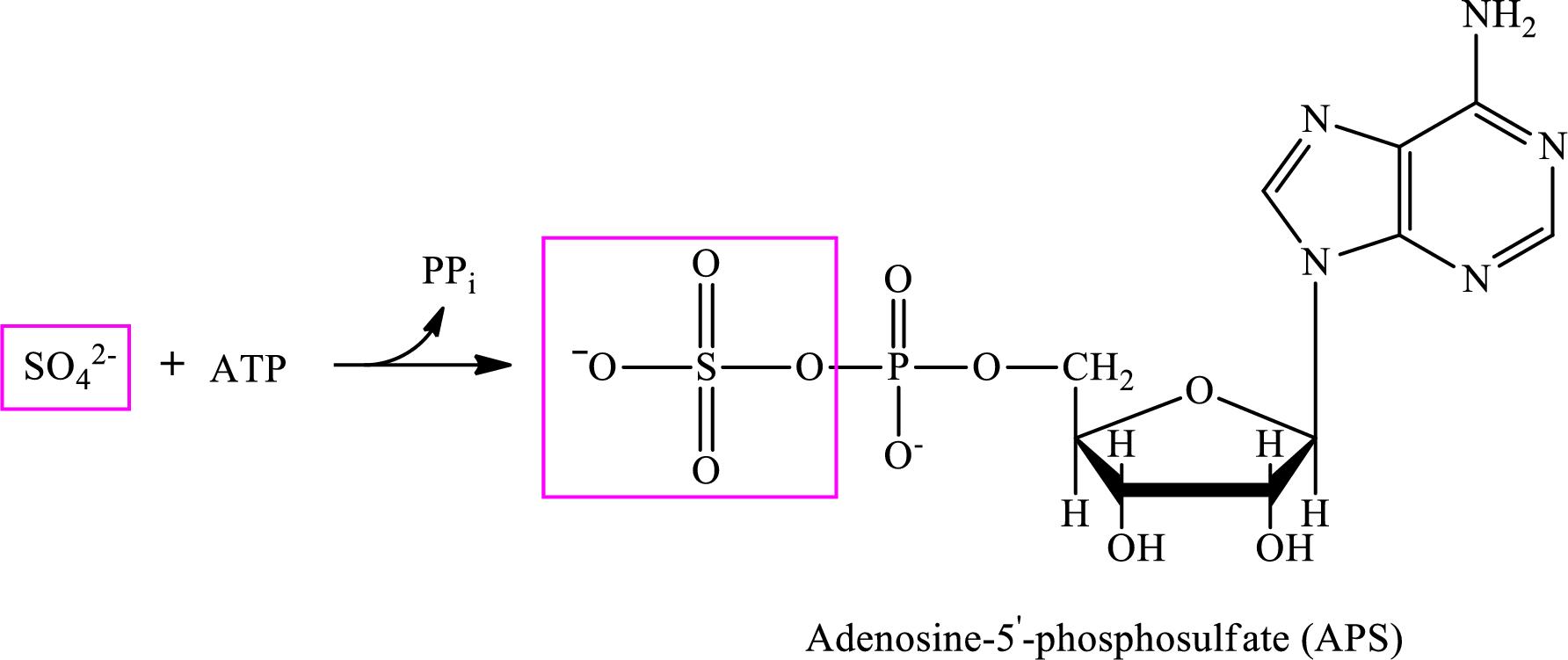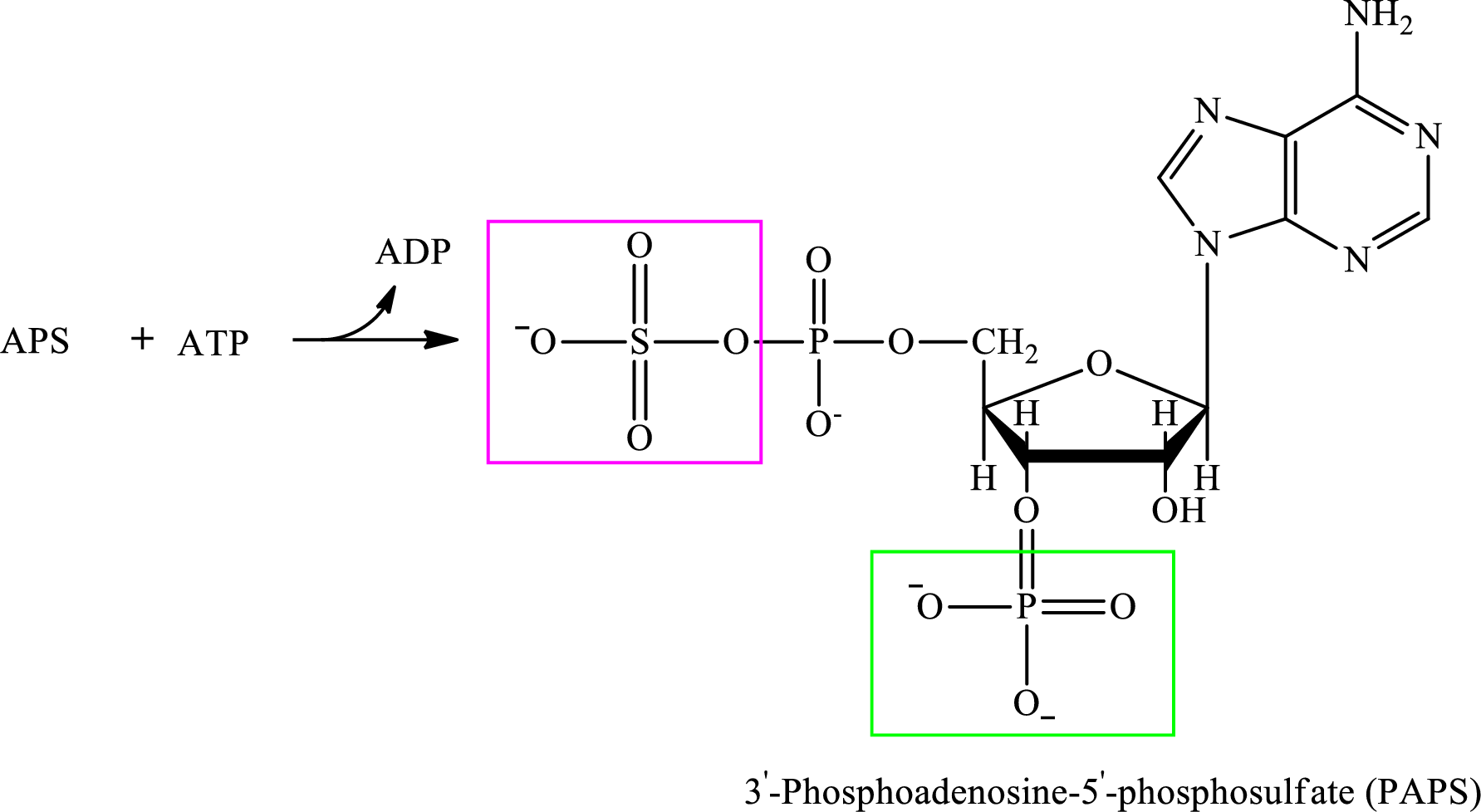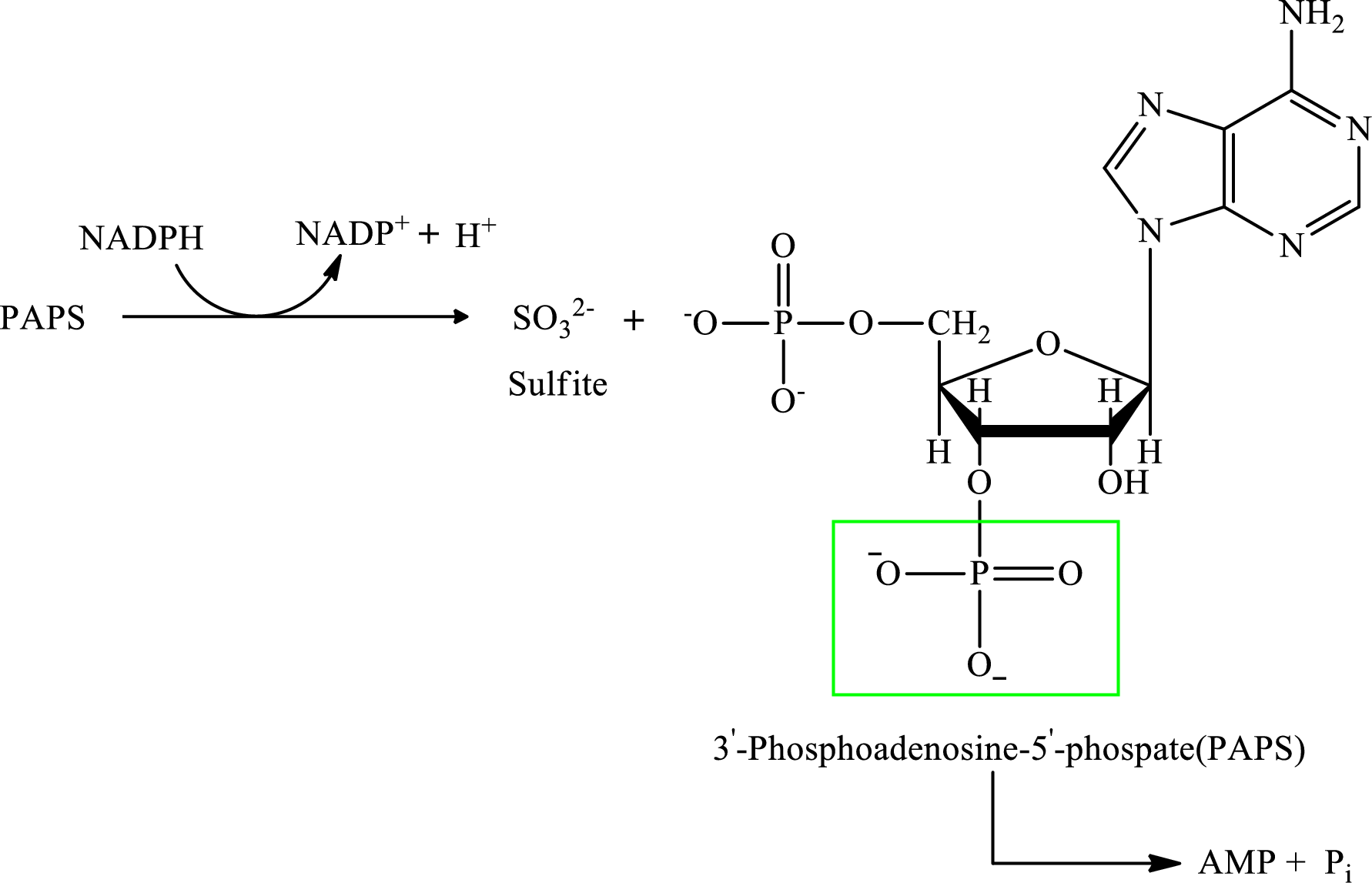
Organic And Biological Chemistry
7th Edition
ISBN: 9781305638686
Author: H. Stephen Stoker
Publisher: Brooks Cole
expand_more
expand_more
format_list_bulleted
Concept explainers
Question
Chapter 15.8, Problem 3QQ
Interpretation Introduction
Interpretation: To determine the reactant in the first step of the sulfate assimilation process.
Concept introduction: Sulfate assimilation is the process used for the production of hydrogen sulfide. The starting material for sulfate assimilation is sulfate ion. It is an oxidation-reduction process as the sulfur in sulfate ion is in oxidized form and in hydrogen sulfide it is present in the reduced form.
The conversion of sulfate ion to sulfide ion via sulfate assimilation occurs in 4 steps. These steps are as follows:
Step 1:

Step 2:

Step 3:

Step 4:

Expert Solution & Answer
Trending nowThis is a popular solution!

Students have asked these similar questions
If is was a very hot day, what would the aldol condensation product be? *see image
Please help me with number 1-3. Thank you so much.
Draw the major product of this reaction ingnore the inorganic byproducts. 1. NaOCH2CH3 at 25 C 2. PhCH2Br (1 eq)
Chapter 15 Solutions
Organic And Biological Chemistry
Ch. 15.1 - Which of the following statements about dietary...Ch. 15.1 - Dietary protein materials as they leave the...Ch. 15.1 - Prob. 3QQCh. 15.1 - Which of the following is not a proteolytic...Ch. 15.2 - The dominant use for the amino acids of the amino...Ch. 15.2 - The most abundant amino acid in the amino acid...Ch. 15.2 - Prob. 3QQCh. 15.3 - The reactants in a transamination reaction are a....Ch. 15.3 - Prob. 2QQCh. 15.3 - Prob. 3QQ
Ch. 15.3 - Prob. 4QQCh. 15.3 - Prob. 5QQCh. 15.3 - Prob. 6QQCh. 15.4 - Prob. 1QQCh. 15.4 - Prob. 2QQCh. 15.4 - Prob. 3QQCh. 15.4 - Prob. 4QQCh. 15.4 - Prob. 5QQCh. 15.4 - In the urea cycle, the urea-producing step...Ch. 15.5 - Which of the following statements concerning the...Ch. 15.5 - Prob. 2QQCh. 15.5 - Which of the following statements concerning the...Ch. 15.5 - Prob. 4QQCh. 15.6 - Prob. 1QQCh. 15.6 - Prob. 2QQCh. 15.6 - Prob. 3QQCh. 15.7 - Prob. 1QQCh. 15.7 - Prob. 2QQCh. 15.7 - In the degradation of heme, which of the following...Ch. 15.7 - In the degradation of heme, the iron atom present...Ch. 15.8 - In degradation of the sulfur-containing amino acid...Ch. 15.8 - Prob. 2QQCh. 15.8 - Prob. 3QQCh. 15.8 - Prob. 4QQCh. 15.9 - Prob. 1QQCh. 15.9 - Prob. 2QQCh. 15.9 - Prob. 3QQCh. 15.10 - Transamination reactions require the cofactor PLP...Ch. 15.10 - Prob. 2QQCh. 15.10 - Prob. 3QQCh. 15 - Prob. 15.1EPCh. 15 - Indicate whether each of the following aspects of...Ch. 15 - Prob. 15.3EPCh. 15 - Prob. 15.4EPCh. 15 - Prob. 15.5EPCh. 15 - Prob. 15.6EPCh. 15 - Prob. 15.7EPCh. 15 - Prob. 15.8EPCh. 15 - Prob. 15.9EPCh. 15 - Prob. 15.10EPCh. 15 - Prob. 15.11EPCh. 15 - Prob. 15.12EPCh. 15 - Prob. 15.13EPCh. 15 - Indicate whether each of the following statements...Ch. 15 - Prob. 15.15EPCh. 15 - Prob. 15.16EPCh. 15 - Prob. 15.17EPCh. 15 - What are the four major uses for amino acids...Ch. 15 - With the help of Table 26-1, classify each of the...Ch. 15 - Prob. 15.20EPCh. 15 - Prob. 15.21EPCh. 15 - Prob. 15.22EPCh. 15 - Prob. 15.23EPCh. 15 - Prob. 15.24EPCh. 15 - Prob. 15.25EPCh. 15 - Prob. 15.26EPCh. 15 - Prob. 15.27EPCh. 15 - Prob. 15.28EPCh. 15 - Prob. 15.29EPCh. 15 - Prob. 15.30EPCh. 15 - Prob. 15.31EPCh. 15 - Prob. 15.32EPCh. 15 - Prob. 15.33EPCh. 15 - Prob. 15.34EPCh. 15 - Prob. 15.35EPCh. 15 - Prob. 15.36EPCh. 15 - Prob. 15.37EPCh. 15 - Prob. 15.38EPCh. 15 - Prob. 15.39EPCh. 15 - Prob. 15.40EPCh. 15 - Prob. 15.41EPCh. 15 - Prob. 15.42EPCh. 15 - Draw the structure of the -keto acid produced from...Ch. 15 - Draw the structure of the -keto acid produced from...Ch. 15 - Prob. 15.45EPCh. 15 - Prob. 15.46EPCh. 15 - Prob. 15.47EPCh. 15 - Prob. 15.48EPCh. 15 - Prob. 15.49EPCh. 15 - Prob. 15.50EPCh. 15 - Prob. 15.51EPCh. 15 - Prob. 15.52EPCh. 15 - Prob. 15.53EPCh. 15 - Prob. 15.54EPCh. 15 - What is a carbamoyl group?Ch. 15 - Prob. 15.56EPCh. 15 - Prob. 15.57EPCh. 15 - Prob. 15.58EPCh. 15 - Prob. 15.59EPCh. 15 - Prob. 15.60EPCh. 15 - Prob. 15.61EPCh. 15 - Prob. 15.62EPCh. 15 - Prob. 15.63EPCh. 15 - Prob. 15.64EPCh. 15 - Prob. 15.65EPCh. 15 - Prob. 15.66EPCh. 15 - Prob. 15.67EPCh. 15 - Prob. 15.68EPCh. 15 - Prob. 15.69EPCh. 15 - Prob. 15.70EPCh. 15 - Prob. 15.71EPCh. 15 - Prob. 15.72EPCh. 15 - Prob. 15.73EPCh. 15 - Prob. 15.74EPCh. 15 - Prob. 15.75EPCh. 15 - Prob. 15.76EPCh. 15 - Prob. 15.77EPCh. 15 - Prob. 15.78EPCh. 15 - Prob. 15.79EPCh. 15 - Prob. 15.80EPCh. 15 - Prob. 15.81EPCh. 15 - Prob. 15.82EPCh. 15 - Prob. 15.83EPCh. 15 - Prob. 15.84EPCh. 15 - Prob. 15.85EPCh. 15 - Prob. 15.86EPCh. 15 - Prob. 15.87EPCh. 15 - What is the starting material for the biosynthesis...Ch. 15 - Prob. 15.89EPCh. 15 - Prob. 15.90EPCh. 15 - Prob. 15.91EPCh. 15 - Prob. 15.92EPCh. 15 - Prob. 15.93EPCh. 15 - What are the structural differences between...Ch. 15 - Prob. 15.95EPCh. 15 - Prob. 15.96EPCh. 15 - Which bile pigment is responsible for the yellow...Ch. 15 - Prob. 15.98EPCh. 15 - Prob. 15.99EPCh. 15 - Prob. 15.100EPCh. 15 - Prob. 15.101EPCh. 15 - Prob. 15.102EPCh. 15 - Prob. 15.103EPCh. 15 - Prob. 15.104EPCh. 15 - Prob. 15.105EPCh. 15 - Indicate whether each of the following statements...Ch. 15 - Prob. 15.107EPCh. 15 - Prob. 15.108EPCh. 15 - Prob. 15.109EPCh. 15 - Prob. 15.110EPCh. 15 - Prob. 15.111EPCh. 15 - Prob. 15.112EPCh. 15 - Prob. 15.113EPCh. 15 - Prob. 15.114EPCh. 15 - Prob. 15.115EPCh. 15 - Prob. 15.116EP
Knowledge Booster
Learn more about
Need a deep-dive on the concept behind this application? Look no further. Learn more about this topic, chemistry and related others by exploring similar questions and additional content below.Similar questions
- At 90ºC the vapor pressure of ortho-xylene is 20 kPa and that of meta-xylene is 18 kPa. What is the composition of the vapor in equilibrium with a mixture in which the mole fraction of o-xylene is 0.60?arrow_forwardDraw the products of this reduction of a ketone with sodium borohydride. Use a dash or wedge bond to indicate the stereochemistry of substituents on asymmetric centers, where applicableIgnore any inorganic byproducts. 1) NaBH4 2) HCI/H2O Select to Drawarrow_forwardWhy do you think people who live at high altitudes are advised to add salt to water when boiling food like pasta? What mole fraction of NaCl is needed to raise the boiling point of H2O by 3˚C? Does the amount of salt added to water (typically about one teaspoon to four quarts of water) substantially change the boiling point? (Kb (H2O) = 0.51˚C/molal.)arrow_forward
- pls help asaparrow_forwardpls help asaparrow_forward9. Consider the following galvanic cell: Fe (s) | Fe(NO3)2 (aq) || Sn(NO3)2 (aq) | Sn (s) a. Write an equation for the half reactions occurring at the anode and cathode. b. Calculate the standard cell potential Show all of your work. c. Draw and label the galvanic cell, including the anode and cathode, direction of electron flow, and direction of ion migration.arrow_forward
- pls help asaparrow_forward11. Use the equation below to answer the following questions: 2 Al(s) + 3 Cd(NO3)2 (aq) → 2 Al(NO3)3 (aq) + 3 Cd(s) a. What is the net ionic equation for the reaction? b. Which species is a spectator ion in this reaction? Define a spectator ion. c. Identify the oxidizing agent and the reducing agent.arrow_forwardpls help asaparrow_forward
arrow_back_ios
SEE MORE QUESTIONS
arrow_forward_ios
Recommended textbooks for you
 General, Organic, and Biological ChemistryChemistryISBN:9781285853918Author:H. Stephen StokerPublisher:Cengage Learning
General, Organic, and Biological ChemistryChemistryISBN:9781285853918Author:H. Stephen StokerPublisher:Cengage Learning Organic And Biological ChemistryChemistryISBN:9781305081079Author:STOKER, H. Stephen (howard Stephen)Publisher:Cengage Learning,
Organic And Biological ChemistryChemistryISBN:9781305081079Author:STOKER, H. Stephen (howard Stephen)Publisher:Cengage Learning,

General, Organic, and Biological Chemistry
Chemistry
ISBN:9781285853918
Author:H. Stephen Stoker
Publisher:Cengage Learning

Organic And Biological Chemistry
Chemistry
ISBN:9781305081079
Author:STOKER, H. Stephen (howard Stephen)
Publisher:Cengage Learning,